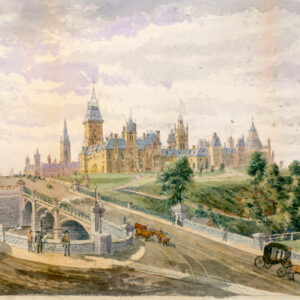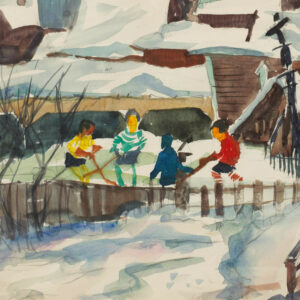-
Takeuchi, Norman (Japanese Canadian, b.1937)
Born in Vancouver, Ottawa-based artist Norman Takeuchi produced mostly abstract paintings until he began to directly address the complexities of his Japanese Canadian heritage in his work. In 1942 his family was forcibly relocated into the B.C. interior alongside many other Japanese Canadians who were interned by the Canadian government during the Second World War. His paintings and mixed media works now contain references that both celebrate his identity and confront Canada’s systematic mistreatment of Japanese Canadians.
-
Tanabe, Takao (Canadian, b. 1926)
Tanabe is a prominent British Columbia painter. Interned along with his family and the majority of Japanese Canadians under government policy during the Second World War, he went on to study art in Canada, the United States, England, and Japan. Tanabe’s early work was influenced by Japanese aesthetics and by the hard-edged style he was exposed to in New York City in the 1950s and 1960s. After he returned to Vancouver in 1980, he turned from abstraction to landscape painting.
-
Thomas, Jeff (urban-Iroquois, b. 1956)
Photographer and curator whose work is informed by the absent identity of the “urban Iroquois.” Thomas seeks to create an image archive of his experiences as an Iroquois man living in cities and to place Indigenous peoples in contemporary urban contexts, sometimes with a wry tone. His series Indians on Tour adopts a street photography aesthetic to capture plastic Indigenous figurines within city scenes.
-
Thomson, Tom (Canadian, 1877–1917)
A seminal figure in the creation of a national school of painting, Thomson is known for a bold vision of Algonquin Park—aligned stylistically with Post-Impressionism and Art Nouveau—that has come to symbolize both the Canadian landscape and Canadian landscape painting. Thomson and the members of what would in 1920 become the Group of Seven profoundly influenced one another’s work. (See Tom Thomson: Life & Work by David P. Silcox.)
-
Topley, William J. (Canadian, 1845–1930)
A prominent photographic portraitist, Topley partnered with photographer and entrepreneur William Notman to establish a Notman Studio in Ottawa in 1868. In 1875 he launched his own portrait business, Topley Studio, which he operated for nearly five decades. Topley produced portraits of politicians and Ottawa’s elite. Library and Archives Canada holds a comprehensive collection of Topley Studio’s glass plates and other records.
-
Tourbin, Dennis (Canadian, 1946–1998)
An Ottawa-based artist, author, and activist who famously addressed the 1970 October Crisis in his work. The Crisis had a profound effect on Tourbin, who saw it as launching the nation into “the media age.” He incorporated news headlines and press clippings into his bright, collage-inspired work and performance pieces. Tourbin was active in artist-run centres across southwestern Ontario.
-
Town, Harold (Canadian, 1924–1990)
Town was a founding member of Painters Eleven and a leader in Toronto’s art scene in the 1950s and 1960s. An internationally recognized abstract artist, he created paintings, collages, sculptures, and prints with brilliant effect and developed a unique form of monotype, “single autographic prints.” (See Harold Town: Life & Work by Gerta Moray.)
-
Trottier, Gerald (Canadian, 1925–2004)
An Ottawa-based painter, printmaker, and educator who drew inspiration from medieval art and integrated its spiritual subjects into his distinctly modern style. Trottier studied in New York and Europe before returning to Canada to work as a designer at the CBC in Ottawa. He is recognized for his largescale mosaic mural on the Carleton University campus. Trottier represented Canada at the 1965 São Paulo Biennial.
-
 About the Author
About the Author
Jim Burant is an Adjunct Professor of Art History at Carleton University, as well as Director of the Ontario Region of the National Archival Appraisal Board of Canada.
-
 More Online Art Books
More Online Art Books
Read online or download the ACI’s incredible library of art books for free in French and English.
Learn More -
 Read from Beginning
Read from Beginning
From a rough and tumble lumber town, Ottawa has become a vibrant metropolitan centre with a centre of artistic excellence.
Learn More
